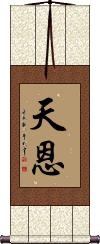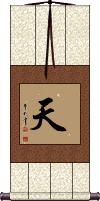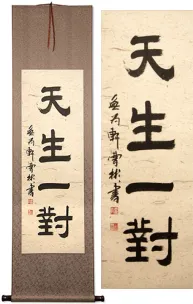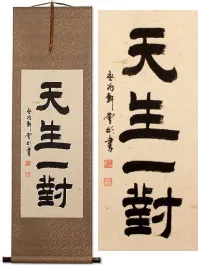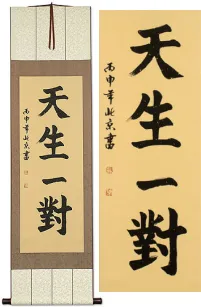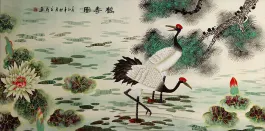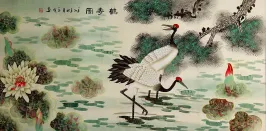Many custom options...
And formats...

The name Heaven Above in Chinese / Japanese...
Buy a Heaven Above calligraphy wall scroll here!
Personalize your custom “Heaven Above” project by clicking the button next to your favorite “Heaven Above” title below...
Grace from Heaven / Grace from God
天恩 is the deepest way to say “Heaven's Grace” or “God's Grace” in Chinese.
The first character means Heaven or sky (referring, in this case, to the domain of God).
The second character means grace, blessings, benevolence, favor/favour, acts of kindness, merits, or beneficial influence.
This title can also be defined as:
Blessings of Heaven, Favor of the Emperor, Divination's luckiest day, or blessings of nature. Note: When you see “Emperor” above, remember that the Emperor, like the Pope, is theoretically chosen by God or seen as an emissary or conduit of God in ancient Asian culture. It would only be read that way in a certain context, such as “The Emperor, in his mercy, bestowed upon him Heaven's Grace, and the prisoner was set free.”
Note: Technically, this is a Japanese word too (pronounced "ten-on") but it’s rarely used in Japan anymore. Therefore, this title is best if your audience is Chinese.
Heaven
天 means “heaven” or “sky” in Chinese, Japanese Kanji, and old Korean Hanja.
The context determines if you are talking about heaven or the sky above (often they are the same concept).
When combined with other characters, words like “today” and “tomorrow” are created. While sometimes the character for “sun” is used to mean “day,” often “sky” represents “day” in Asian languages.
Example: 今天 (this sky) = “today,” 明天 (next sky) = “tomorrow” in modern Chinese and Japanese.
In Chinese culture, regardless of which religion, it's almost always assumed that God (and any other deities) live up above the sky. The concept of God living in the sky is likely the reason heaven is associated with this character.
The equation goes something like this: God's domain is the sky, thus, the sky is heaven.
Note: As a single character, this is a little ambiguous, so you might want to choose our Kingdom of Heaven selection instead.
This in-stock artwork might be what you are looking for, and ships right away...
Gallery Price: $61.00
Your Price: $33.88
Gallery Price: $61.00
Your Price: $33.88
Gallery Price: $61.00
Your Price: $33.88
Gallery Price: $61.00
Your Price: $33.88
Gallery Price: $61.00
Your Price: $33.88
Gallery Price: $340.00
Your Price: $188.88
Gallery Price: $340.00
Your Price: $188.88
Gallery Price: $72.00
Your Price: $39.88
Not the results for heaven above that you were looking for?
Below are some entries from our dictionary that may match your heaven above search...
| Characters If shown, 2nd row is Simp. Chinese |
Pronunciation Romanization |
Simple Dictionary Definition |
三界 see styles |
sān jiè san1 jie4 san chieh sangai さんがい |
(1) {Buddh} (See 欲界,色界,無色界) the three realms of existence; (2) (abbreviation) {Buddh} (See 三千大千世界) the whole universe (of a billion worlds) that Buddha enlightened; (3) {Buddh} (See 三世・さんぜ・1) past, present and future existences; (suffix) (4) far-off ...; distant ...; (surname) Mikai Trailokya or Triloka; the three realms; also 三有. It is the Buddhist metaphysical equivalent for the Brahmanic cosmological bhuvanatraya, or triple world of bhūr, bhuvaḥ, and svar, earth, atmosphere, and heaven. The Buddhist three are 欲, 色, and 無色界, i.e. world of sensuous desire, form, and formless world of pure spirit. (a) 欲界 Kāmadhātu is the realm of sensuous desire, of 婬 and 食 sex and food; it includes the six heavens of desire, the human world, and the hells. (b) 色界 Rūpadhātu is the realm of form, meaning 質礙 that which is substantial and resistant: it is above the lust-world and contains (so to speak) bodies, palaces, things, all mystic and wonderful一a semi-material conception like that in Revelation; it is represented in the 四禪天, or Brahmalokas. (c) 無色界 Arūpadhātu, or ārūpyadhātu, is the formless realm of pure spirit, where there are no bodies, places, things, at any rate none to which human terms would apply, but where the mind dwells in mystic contemplation; its extent is indefinable, but it is, conceived of in four stages, i,e. 四空處 the four "empty" regions, or regions of space in the immaterial world, which are 四無色 the four "formless" realms, or realms beyond form; being above the realm of form, their bounds cannot be defined. v. 倶舍論世間品. |
三身 see styles |
sān shēn san1 shen1 san shen sanjin; sanshin さんじん; さんしん |
{Buddh} trikaya (three bodies of the Buddha); (surname) Sanmi trikāya. 三寶身 The threefold body or nature of a Buddha, i.e. the 法, 報, and 化身, or dharmakāya, sambhogakāya, and nirmāṇakāya. The three are defined as 自性, 受用, and 變化, the Buddha-body per se, or in its essential nature; his body of bliss, which he "receives" for his own "use" and enjoyment; and his body of transformation, by which he can appear in any form; i.e. spiritual, or essential; glorified; revealed. While the doctrine of the trikāya is a Mahāyāna concept, it partly results from the Hīnayāna idealization of the earthly Buddha with his thirty-two signs, eighty physical marks, clairvoyance, clairaudience, holiness, purity, wisdom, pity, etc. Mahāyāna, however, proceeded to conceive of Buddha as the Universal, the All, with infinity of forms, yet above all our concepts of unity or diversity. To every Buddha Mahāyāna attributed a three-fold body: that of essential Buddha; that of joy or enjoyment of the fruits of his past saving labours; that of power to transform himself at will to any shape for omnipresent salvation of those who need him. The trinity finds different methods of expression, e.g. Vairocana is entitled 法身, the embodiment of the Law, shining everywhere, enlightening all; Locana is 報身; c.f. 三賓, the embodiment of purity and bliss; Śākyamuni is 化身 or Buddha revealed. In the esoteric sect they are 法 Vairocana, 報 Amitābha, and 化 Śākyamuni. The 三賓 are also 法 dharma, 報 saṅgha, 化 buddha. Nevertheless, the three are considered as a trinity, the three being essentially one, each in the other. (1) 法身 Dharmakāya in its earliest conception was that of the body of the dharma, or truth, as preached by Śākyamuni; later it became his mind or soul in contrast with his material body. In Mādhyamika, the dharmakāya was the only reality, i.e. the void, or the immateria1, the ground of all phenomena; in other words, the 眞如 the tathāgatagarbha, the bhūtatathatā. According to the Huayan (Kegon) School it is the 理or noumenon, while the other two are氣or phenomenal aspects. "For the Vijñānavāda... the body of the law as highest reality is the void intelligence, whose infection (saṃkleҫa) results in the process of birth and death, whilst its purification brings about Nirvāṇa, or its restoration to its primitive transparence" (Keith). The "body of the law is the true reality of everything". Nevertheless, in Mahāyāna every Buddha has his own 法身; e.g. in the dharmakāya aspect we have the designation Amitābha, who in his saṃbhogakāya aspect is styled Amitāyus. (2) 報身Sambhogakāya, a Buddha's reward body, or body of enjoyment of the merits he attained as a bodhisattva; in other words, a Buddha in glory in his heaven. This is the form of Buddha as an object of worship. It is defined in two aspects, (a) 自受用身 for his own bliss, and (b) 他受用身 for the sake of others, revealing himself in his glory to bodhisattvas, enlightening and inspiring them. By wisdom a Buddha's dharmakāya is attained, by bodhisattva-merits his saṃbhogakāya. Not only has every Buddha all the three bodies or aspects, but as all men are of the same essence, or nature, as Buddhas, they are therefore potential Buddhas and are in and of the trikāya. Moreover, trikāya is not divided, for a Buddha in his 化身 is still one with his 法身 and 報身, all three bodies being co-existent. (3) 化身; 應身; 應化身 nirmāṇakāya, a Buddha's transformation, or miraculous body, in which he appears at will and in any form outside his heaven, e.g. as Śākyamuni among men. |
上天 see styles |
shàng tiān shang4 tian1 shang t`ien shang tien jouten / joten じょうてん |
Heaven; Providence; God; the sky above; to fly skywards; (euphemism) to die; to pass away; the previous day (or days) (1) (See 下土) sky; the heavens; (2) God; the Lord; the Creator; the Supreme Being; (3) ascension (into heaven); (surname) Jōten to ascend to heaven |
六天 see styles |
liù tiān liu4 tian1 liu t`ien liu tien rokuten ろくてん |
(place-name) Rokuten The six devalokas, i. e. the heavens with sense organs above Sumeru, between the brahmalokas and the earth, i. e. 四王天; 忉利天; 夜摩天; 兜率天; 樂變化天; and 他化自在天. The sixth is the heaven of Mara, v. 六欲天. |
四禪 四禅 see styles |
sì chán si4 chan2 ssu ch`an ssu chan shizen |
(四禪天) The four dhyāna heavens, 四靜慮 (四靜慮天), i. e. the division of the eighteen brahmalokas into four dhyānas: the disciple attains to one of these heavens according to the dhyāna he observes: (1) 初禪天 The first region, 'as large as one whole universe' comprises the three heavens, Brahma-pāriṣadya, Brahma-purohita, and Mahābrahma, 梵輔, 梵衆, and 大梵天; the inhabitants are without gustatory or olfactory organs, not needing food, but possess the other four of the six organs. (2) 二禪天 The second region, equal to 'a small chiliocosmos' 小千界, comprises the three heavens, according to Eitel, 'Parīttābha, Apramāṇābha, and Ābhāsvara, ' i. e. 少光 minor light, 無量光 infinite light, and 極光淨 utmost light purity; the inhabitants have ceased to require the five physical organs, possessing only the organ of mind. (3) 三禪天 The third region, equal to 'a middling chiliocosmos '中千界, comprises three heavens; Eitel gives them as Parīttaśubha, Apramāṇaśubha, and Śubhakṛtsna, i. e. 少淨 minor purity, 無量淨 infinite purity, and 徧淨 universal purity; the inhabitants still have the organ of mind and are receptive of great joy. (4) 四禪天 The fourth region, equal to a great chiliocosmos, 大千界, comprises the remaining nine brahmalokas, namely, Puṇyaprasava, Anabhraka, Bṛhatphala, Asañjñisattva, Avṛha, Atapa, Sudṛśa, Sudarśana, and Akaniṣṭha (Eitel). The Chinese titles are 福生 felicitous birth, 無雲 cloudless, 廣果 large fruitage, 無煩 no vexations, atapa is 無熱 no heat, sudṛśa is 善見 beautiful to see, sudarśana is 善現 beautiful appearing, two others are 色究竟 the end of form, and 無想天 the heaven above thought, but it is difficult to trace avṛha and akaniṣṭha; the inhabitants of this fourth region still have mind. The number of the dhyāna heavens differs; the Sarvāstivādins say 16, the 經 or Sutra school 17, and the Sthavirāḥ school 18. Eitel points out that the first dhyāna has one world with one moon, one mem, four continents, and six devalokas; the second dhyāna has 1, 000 times the worlds of the first; the third has 1, 000 times the worlds of the second; the fourth dhyāna has 1, 000 times those of the third. Within a kalpa of destruction 壞劫 the first is destroyed fifty-six times by fire, the second seven by water, the third once by wind, the fourth 'corresponding to a state of absolute indifference' remains 'untouched' by all the other evolutions; when 'fate (天命) comes to an end then the fourth dhyāna may come to an end too, but not sooner'. |
夜摩 see styles |
yè mó ye4 mo2 yeh mo yama |
Yama, 'originally the Aryan god of the dead, living in a heaven above the world, the regent of the South; but Brahminism transferred his abode to hell. Both views have been retained by Buddhism.' Eitel. Yama in Indian mythology is ruler over the dead and judge in the hells, is 'grim in aspect, green in colour, clothed in red, riding on a buffalo, and holding a club in one hand and noose in the other': he has two four-eyed watch-dogs. M. W. The usual form is 閻摩 q. v. |
大日 see styles |
dà rì da4 ri4 ta jih dainichi だいにち |
Mahavairocana (Tathagata); Great Sun; Supreme Buddha of Sino-Japanese esoteric Buddhism; (place-name, surname) Dainichi Vairocana, or Mahāvairocana 大日如來; 遍照如來; 摩訶毘盧遮那; 毘盧遮那; 大日覺王 The sun, "shining everywhere" The chief object of worship of the Shingon sect in Japan, "represented by the gigantic image in the temple at Nara." (Eliot.) There he is known as Dai-nichi-nyorai. He is counted as the first, and according to some, the origin of the five celestial Buddhas (dhyāni-buddhas, or jinas). He dwells quiescent in Arūpa-dhātu, the Heaven beyond form, and is the essence of wisdom (bodhi) and of absolute purity. Samantabhadra 普賢 is his dhyāni-bodhisattva. The 大日經 "teaches that Vairocana is the whole world, which is divided into Garbhadhātu (material) and Vajradhātu (indestructible), the two together forming Dharmadhātu. The manifestations of Vairocana's body to himself―that is, Buddhas and Bodhisattvas ―are represented symbolically by diagrams of several circles ". Eliot. In the 金剛界 or vajradhātu maṇḍala he is the center of the five groups. In the 胎藏界 or Garbhadhātu he is the center of the eight-leaf (lotus) court. His appearance, symbols, esoteric word, differ according to the two above distinctions. Generally he is considered as an embodiment of the Truth 法, both in the sense of dharmakāya 法身 and dharmaratna 法寳. Some hold Vairocana to be the dharmakāya of Śākyamuni 大日與釋迦同一佛 but the esoteric school denies this identity. Also known as 最高顯廣眼藏如來, the Tathagata who, in the highest, reveals the far-reaching treasure of his eye, i.e. the sun. 大日大聖不動明王 is described as one of his transformations. Also, a śramaņa of Kashmir (contemporary of Padma-saṃbhava); he is credited with introducing Buddhism into Khotan and being an incarnation of Mañjuśrī; the king Vijaya Saṃbhava built a monastery for him. |
天宮 天宫 see styles |
tiān gōng tian1 gong1 t`ien kung tien kung tiangon; tenkyuu / tiangon; tenkyu ティアンゴン; てんきゅう |
Temple in Heaven (e.g. of the Jade Emperor); Tiangong, Chinese space station program Tiangong (Chinese space program); (surname) Amemiya devapura; devaloka; the palace of devas, the abode of the gods, i. e. the six celestial worlds situated above the Meru, between the earth and the Brahmalokas. v. 六天. |
願身 愿身 see styles |
yuàn shēn yuan4 shen1 yüan shen |
The resolve of a Buddha to be born in the Tuṣita heaven for the work of saving all beings, also idem願佛 above. |
五種天 五种天 see styles |
wǔ zhǒng tiān wu3 zhong3 tian1 wu chung t`ien wu chung tien goshu ten |
(1) 名天 famous rulers on earth styled 天王, 天子; (2) 生天 the highest incarnations of the six paths; (3) 淨天 the pure, or the saints, from śrāvakas to pratyekabuddhas, and (4) 義天 all bodhisattvas above the ten stages 十住, and (5) 第一義天 a supreme heaven with bodhisattvas and Buddhas in eternal immutability; 涅槃經 23. Cf. 天宮. |
化樂天 化乐天 see styles |
huà lè tiān hua4 le4 tian1 hua le t`ien hua le tien keraku ten |
Nirmāṇarati, 樂變化天 the fifth of the six desire-heavens, 640, 000 yojanas above Meru; it is next above the Tuṣita, or fourth deva. loka; a day is equal to 800 human years; life lasts for 8, 000 years; its inhabitants are eight yojanas in height, and light-emitting; mutual smiling produces impregnation and children are born on the knees by metamorphosis, at birth equal in development to human children of twelve— hence the 'joy-born heaven'. |
四空處 四空处 see styles |
sì kōng chù si4 kong1 chu4 ssu k`ung ch`u ssu kung chu shi kūsho |
(or四空天) catur-ārūpya brahmalokas; also 四無色界 and see 四空定. The four immaterial or formless heavens, arūpa-dhātu, above the eighteen brahmalokas: (1) 空無邊處 ākāśānantyāyatana, also termed 虛空 處 the state or heaven of boundless space; (2) 識無邊處 vijñānanāntyāyatana, of boundless knowledge; (3) 無所有處 ākiñcanyāyatana, of nothing, or nonexistence; (4) 非想非非想處 naivasanjñānasañjnāyatana, also styled 非有想非無想 the state of neither thinking nor not thinking (which may resemble a state of intuition). Existence in the first state lasts 20, 000 great kalpas, increasing respectively to 40, 000, 60, 000 and 80, 000 in the other three. |
愛身天 爱身天 see styles |
ài shēn tiān ai4 shen1 tian1 ai shen t`ien ai shen tien aishin ten |
The heaven of lovely form in the desire-realm, but said to be above the devalokas; cf. sudṛśa 善現. |
虛空天 虚空天 see styles |
xū kōng tiān xu1 kong1 tian1 hsü k`ung t`ien hsü kung tien kokū ten |
The four heavens of desire above Meru in space, from the Yama heaven upwards. |
雲の上 see styles |
kumonoue / kumonoe くものうえ |
(exp,n) (1) above the clouds; heaven; (exp,n) (2) the Imperial Court; (exp,n) (3) something unreachable; place of out of reach |
天上天下 see styles |
tiān shàng tiān xià tian1 shang4 tian1 xia4 t`ien shang t`ien hsia tien shang tien hsia tenjoutenge / tenjotenge てんじょうてんげ |
(n,adv) (yoji) the whole world; throughout heaven and earth heavens above and [this earth] below the heavens |
四十九重摩尼殿 see styles |
sì shí jiǔ zhòng mó ní diàn si4 shi2 jiu3 zhong4 mo2 ni2 dian4 ssu shih chiu chung mo ni tien shijūkujū mani den |
(or 四十九重如意殿) . The maṇi, or Pearl palace of forty-nine stories above the Tuṣita heaven. |
上有天堂,下有蘇杭 上有天堂,下有苏杭 see styles |
shàng yǒu tiān táng , xià yǒu sū háng shang4 you3 tian1 tang2 , xia4 you3 su1 hang2 shang yu t`ien t`ang , hsia yu su hang shang yu tien tang , hsia yu su hang |
lit. there is heaven above, and there is 蘇杭|苏杭[Su1 Hang2] below (idiom); fig. the beauty and affluence of Suzhou and Hangzhou is comparable with heaven |
The following table may be helpful for those studying Chinese or Japanese...
| Title | Characters | Romaji (Romanized Japanese) | Various forms of Romanized Chinese | |
| Grace from Heaven Grace from God | 天恩 | tiān ēn / tian1 en1 / tian en / tianen | t`ien en / tienen / tien en | |
| Heaven | 天 | ten | tiān / tian1 / tian | t`ien / tien |
Successful Chinese Character and Japanese Kanji calligraphy searches within the last few hours...
